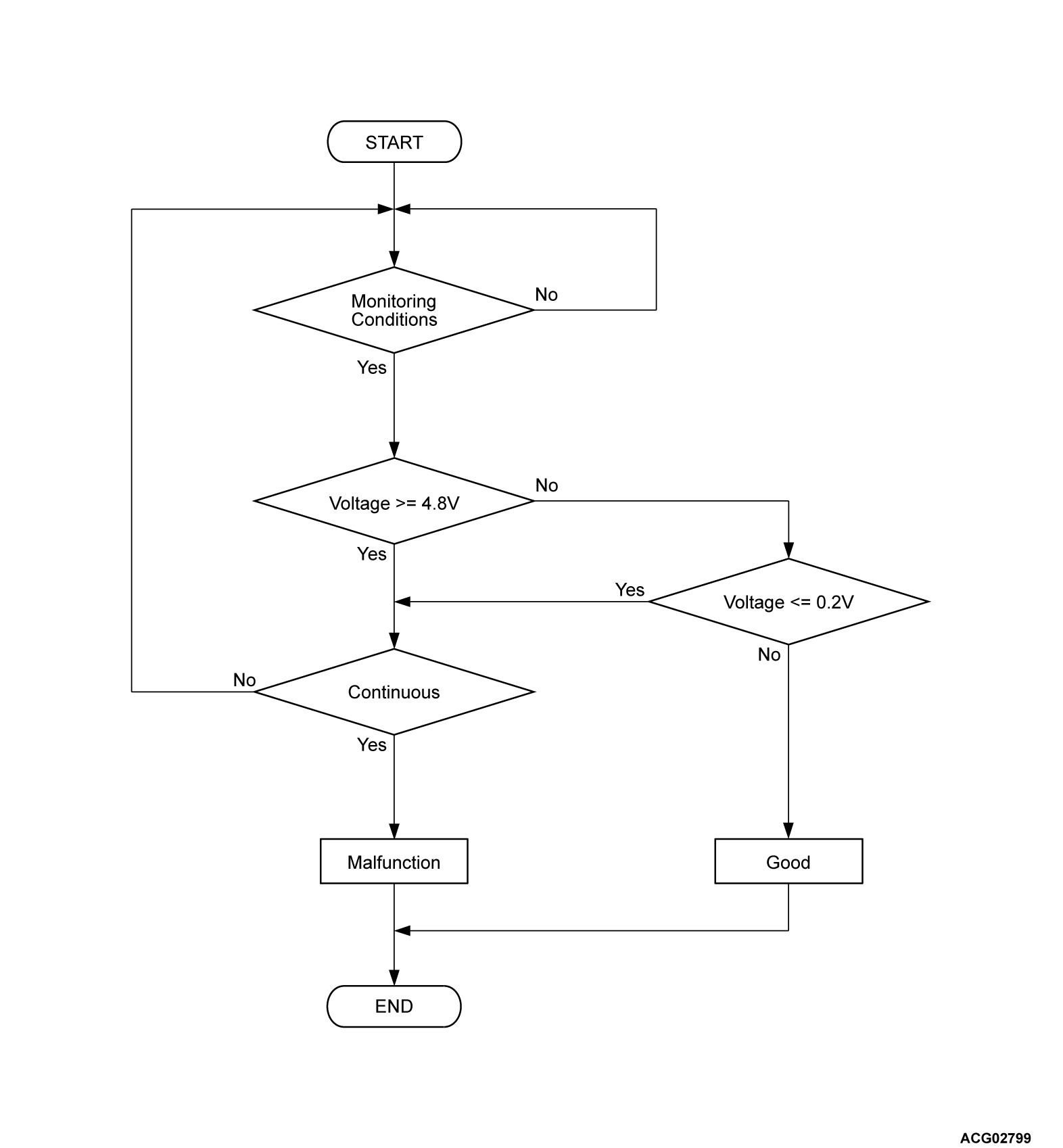DTC P1E01: PTC Heater TEMP. Sensor Low
MONITOR EXECUTION
- Continuous
MONITOR EXECUTION CONDITIONS (Other monitor and Sensor)
Other Monitor (There is no temporary DTC set in memory for the item monitored below)
- Not applicable
Sensor (The sensor below is determined to be normal)
- Not applicable
DTC SET CONDITIONS
Check Conditions
- battery management unit (BMU) power supply voltage is 8 volts to 16 volts.
- Time after above conditions satisfy is more than 1 second.
Judgment Criterion
- Change of the main drive lithium-ion battery heater temperature sensor voltage is less than 0.2 volt for 2 seconds.
FAIL-SAFE AND BACKUP FUNCTION
- Not available
PROBABLE CAUSE
- The main drive lithium-ion battery heater temperature sensor is failed.
- Short circuits to power supply system of main drive lithium-ion battery cooling fan circuit; poor contact of connector.
- The battery management unit (BMU) is failed.
DIAGNOSIS
Required Special Tools
- MB991658: Test harness
STEP 1. Measure the voltage at main drive lithium-ion battery connector.
(1) Disconnect the D-34 main drive lithium-ion battery connector, and measure at the wiring harness side.
(2) Turn on the power supply mode of the electric motor switch without depressing the brake pedal.
(3) Check the voltage between D-34 main drive lithium-ion battery connector (terminal No. 3) and body ground.
OK: 4.7 - 5.3 volts
Is the check result normal?
STEP 2. Measure the resistance at the BMU connector.
(1) Disconnect the BMU connector and D-34 main drive lithium-ion battery connector, and measure at the wiring harness side.
(2) Check the resistance between BMU connector (HTS terminal) and body ground.
OK: No continuity
(3) Check the resistance between BMU connector (HTS terminal) and D-34 main drive lithium-ion battery connector (terminal No. 3).
OK: Continuity exists (2 Ω or less)
Is the check result normal
STEP 3. Measure the resistance at the BMU connector.
(1) Disconnect the BMU connector and D-34 main drive lithium-ion battery connector, and measure at the wiring harness side.
(2) Check the resistance between BMU connector (GHTS terminal) and body ground.
OK: No continuity
(3) Check the resistance between BMU connector (GHTS terminal) and D-34 main drive lithium-ion battery connector (terminal No. 8).
OK: Continuity exists (2 Ω or less)
Is the check result normal
STEP 4. Measure the resistance at the main drive lithium-ion battery connector.
(1) Disconnect the D-34 main drive lithium-ion battery connector, and measure at the main drive lithium-ion battery side.
| note | Do not disconnect other main drive lithium-ion battery connector. |
(2) Check the resistance between D-34 main drive lithium-ion battery connector (terminal No.3) and D-34 main drive lithium-ion battery connector (terminal No.8).
OK: The resistance value corresponding to the temperature detected by the main drive lithium-ion battery heater temperature sensor* is displayed (refer to  ).
).
 ).
).| note | *: As for the temperature, use the numerical value of item No. 442: BMU (SUB) temperature sensor. |
(3) Check the resistance between D-34 main drive lithium-ion battery connector (terminal No.3) and body ground.
OK: No continuity
(4) Check the resistance between D-34 main drive lithium-ion battery connector (terminal No.3) and D-34 main drive lithium-ion battery connector (terminal No.6).
OK: No continuity
Is the check result normal
STEP 5. Measure the resistance at the main drive lithium-ion battery heater temperature sensor connector.
(2) Disconnect the I-26 main drive lithium-ion battery heater temperature sensor connector, and measure at the sensor side.
(3) Check the voltage between I-26 main drive lithium-ion battery heater temperature sensor connector (terminal No. 1) and I-26 main drive lithium-ion battery heater temperature sensor connector (terminal No. 2).
(4) Check the resistance between I-26 main drive lithium-ion battery heater temperature sensor connector (terminal No. 1) and body ground.
OK: No continuity
Is the check result normal?
![[Previous]](../../../buttons/fprev.png)
![[Next]](../../../buttons/fnext.png)


